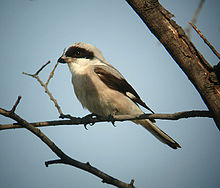| Lesser grey shrike | |
|---|---|

| |
| Scientific classification | |
| Domain: | Eukaryota |
| Kingdom: | Animalia |
| Phylum: | Chordata |
| Class: | Aves |
| Order: | Passeriformes |
| Family: | Laniidae |
| Genus: | Lanius |
| Species: | L. minor
|
| Binomial name | |
| Lanius minor Gmelin, 1788
| |

| |
| Range of L. minor Breeding Non-breeding
| |
The lesser grey shrike (Lanius minor) is a member of the shrike family Laniidae. It breeds in South and Central Europe and western Asia in the summer and migrates to winter quarters in southern Africa in the early autumn, returning in spring. It is a scarce vagrant to western Europe, including Great Britain, usually as a spring or autumn erratic.
It is similar in appearance to the great grey shrike (Lanius excubitor) and the Iberian grey shrike (Lanius meridionalis); both sexes are predominantly black, white and grey, and males have pink-flushed underparts. It is slightly smaller than the great grey shrike, and has a black forehead and relatively longer wings. This species prefers dry open lowlands and is often seen on telephone wires.
This medium-sized passerine eats large insects, especially beetles, butterflies, moths and grasshoppers. Lesser grey shrikes frequently hover when hunting on their breeding grounds, but do not do so while moulting on non-breeding grounds. Like other shrikes, it hunts from prominent perches and sometimes impales corpses on thorns or barbed wire as a "larder".
- ^ BirdLife International (2016). "Lanius minor". IUCN Red List of Threatened Species. 2016: e.T22705038A87339356. doi:10.2305/IUCN.UK.2016-3.RLTS.T22705038A87339356.en. Retrieved 11 November 2021.
